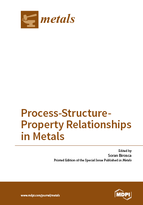Process-Structure-Property Relationships in Metals
A special issue of Metals (ISSN 2075-4701).
Deadline for manuscript submissions: closed (31 August 2016) | Viewed by 134877
Special Issue Editor
Interests: physical metallurgy; deformation mechanism; microstructure characterisation; fracture mechanics and failure mechanism; microtexture and microstructure evolutions during thermomechanical processing and phase transformation of cubic and hcp structures; texture analysis; structure/property relationship; mechanical property of metals; high temperature corrosion; electron microscopy; in-situ observation using SEM; EBSD; neutron and synchrotron X-ray diffraction as well as non-destructive 3D imaging (x-ray micro-tomography)
Special Issues, Collections and Topics in MDPI journals
Special Issue Information
Dear Colleagues,
In this Special Issue of Metals, an open access forum is provided for publishing original papers that the covers direct and effective correlations between a wide range of thermomechanical processing routes and generated microstructure, hence, the final physical and mechanical properties of the materials. The following aspects of the science and engineering of any metals and alloys are of particular interest:
- Original research studies that relate to the understanding of the properties obtained following specific processing/heat treatment route (Experimental, theoretical, and simulation modeling).
- Understanding the mechanisms involved in microstructure evolution and phase transformation during processing of materials, specifically as they relate to the understanding of final mechanical properties.
- Nano/micro/macro structure characterization and chemistry of metals/alloys used in automotive, power generation, nuclear, aerospace, and medical applications.
- Micro/macro texture devolvement during thermo-mechanical processing of metals/alloys.
Dr. Soran Birosca
Guest Editor
Manuscript Submission Information
Manuscripts should be submitted online at www.mdpi.com by registering and logging in to this website. Once you are registered, click here to go to the submission form. Manuscripts can be submitted until the deadline. All submissions that pass pre-check are peer-reviewed. Accepted papers will be published continuously in the journal (as soon as accepted) and will be listed together on the special issue website. Research articles, review articles as well as short communications are invited. For planned papers, a title and short abstract (about 100 words) can be sent to the Editorial Office for announcement on this website.
Submitted manuscripts should not have been published previously, nor be under consideration for publication elsewhere (except conference proceedings papers). All manuscripts are thoroughly refereed through a single-blind peer-review process. A guide for authors and other relevant information for submission of manuscripts is available on the Instructions for Authors page. Metals is an international peer-reviewed open access monthly journal published by MDPI.
Please visit the Instructions for Authors page before submitting a manuscript. The Article Processing Charge (APC) for publication in this open access journal is 2600 CHF (Swiss Francs). Submitted papers should be well formatted and use good English. Authors may use MDPI's English editing service prior to publication or during author revisions.
Keywords
- Metals
- Alloys
- Microstructure
- Deformation
- Microtexture
- Mechanical Property
- Fracture Mechanics
- Texture
- Material Characterisation
- Grain Boundary
- Dislocation
- Slip System
- Twinning
- EBSD






